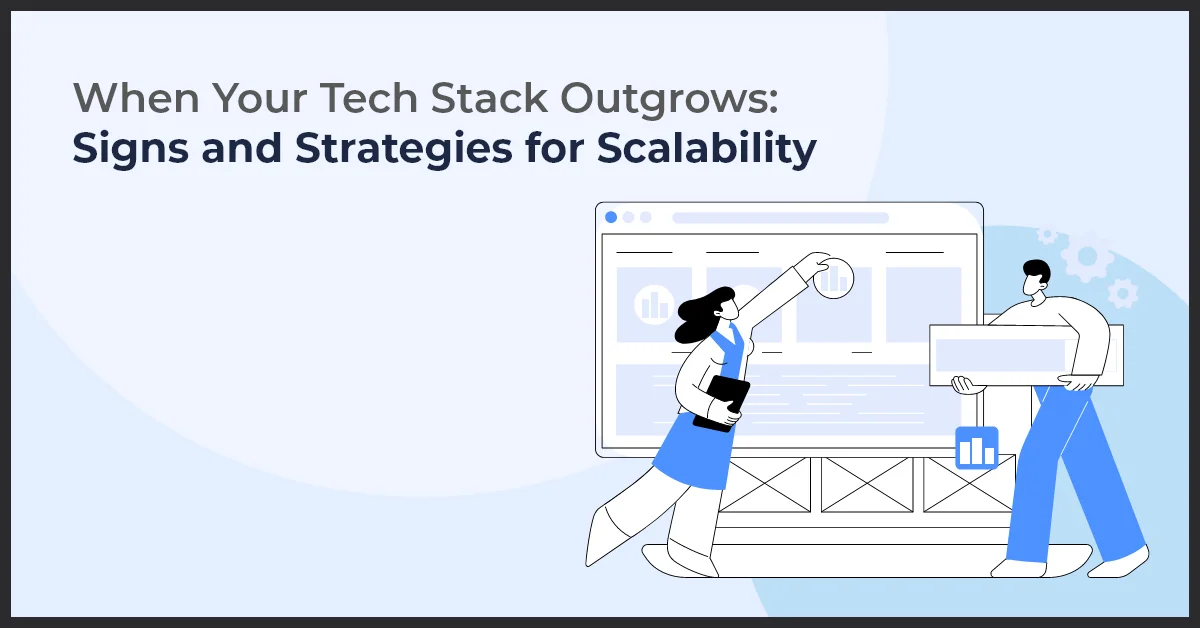Recognizing the Signs Your Tech Stack Needs to Scale

Published on: August 1, 2023
Updated on: March 04, 2025
3038 Views
- Marketing
9 min read
How many apps, tools, and technology does your organization use? Did you say only a handful? Chances are you are missing out on many that you use in the periphery. Statistics reveal that an average mid-market company can use nearly 185 different Apps in its tech stack! You may not be using a hundred anyway, but your dependence on technology has surely increased.
A few years ago, tech stack meant working with simple, run-of-the-mill programs such as Linux, Apache, MySQL, and PHP. But today, the market is overflowing with numerous applications simultaneously used to create high-end products and services. Your dependence on technology will only increase as you focus on creating customer-centric products and services.
The Big Challenge
Dealing with such a huge number of applications is not a mean task. It requires expertise, upskilling and technological innovation. Having a scalable tech stack becomes crucial since competition around is stiff. Marketing executives can only drive growth and meet all their business objectives when they optimally leverage technology.
However, several challenges make scalability an uphill task. Most marketers fail to identify the need to upscale their tech stack. This short-sightedness can cost marketing heavily. While the first step to scaling the tech stack is to identify the flaws in the current stack, it is equally important to understand the challenges ahead. Once these are done, strategizing for adoption, optimizing for performance improvement, and future-proofing the marketing infrastructure can follow. Here, we shall explore all these points in detail.
Signs Your Tech Stack is Outgrowing
You must first identify the potential challenges to scale up your tech stack. Let’s identify some common signs that your tech stack is outgrowing and probably outdated.
- Complexities in Data Management – With increasing marketing efforts, it is natural that your business is dealing with a large volume of data. It is an uphill task to handle and analyze such data, eventually leading to inefficiencies and missed opportunities. If you are staring at volumes of data that are increasingly becoming difficult to analyze, it is a sign that your tech stack needs an upgrade.
Pro Tip: Adopt data management solutions that provide automation and integration capabilities. Utilizing tools that streamline data collection and processing can significantly reduce complexity, allowing your team to focus on analysis and strategy rather than data handling.
- Performance Bottlenecks – Frequent crashes, sluggish response times, and unexplained system slowdowns are signs that your tech stack is working overtime. These issues, if not addressed immediately, can hamper your marketing team’s productivity and negatively impact the overall user experience.
- Limited Analytics Capabilities – Another sign that your tech stack is not performing up to the mark is when it cannot provide you with comprehensive data analysis. It is time to scale up if it lacks the analytics capabilities that help make informed marketing decisions.
- Overall Impact on Business Performance – If you are incurring increased operational costs due to manual workarounds, it indicates that your tech stack has outgrown its performance phase. Inefficient processes and missed opportunities will eventually hinder your overall business performance.
Pro Tip: Conduct a comprehensive review of your current workflows to identify areas for automation. Automating processes can reduce operational costs and improve overall efficiency, allowing your team to focus on high-impact activities that drive business performance.
Figure Out the Scalability Challenges
Once you identify the signs of tech stack instability, your natural response would be to scale up your resources to meet market demands. But unless you understand the challenges associated with scalability, you cannot transition to the next phase seamlessly. Let’s look at some of the common scalability challenges you might encounter.
- Budget and Resource Constraints – You must first consider two major considerations while scaling up your tech stack – the estimated cost of the task and the cost of upskilling your personnel. Getting the best deal may become difficult if you seek cost-effective solutions.
- Balancing Technology with Marketing Strategy – Aligning your marketing strategies with the adoption of advanced technology may seem doable on paper. However, ineffective implementation can lead to disjointed workflows and ineffective campaigns.
- Data Privacy and Security Concerns – Your upgraded tech stack must continue offering your customers data privacy. Unless this happens, you cannot earn your customers’ trust.
- Overcoming Organizational Resistance to Change – Hindrances to the adoption of new technologies can come from internal stakeholders. Overcome this challenge by effectively addressing stakeholder concerns and communicating the benefits of an upgraded tech stack.
Strategic Path to Seamless Scalability
We have discussed the symptoms when your tech stack needs to be made scalable and the challenges en route to scalability. Now let us turn our attention to strategizing. Once you know the challenges likely to make scalability difficult, handling and managing the upcoming adoption can become easier. Let’s dig into some strategies that can help in seamless scalability.
- Conducting a Tech Stack Audit and Gap Analysis – Conduct a gap analysis to audit your existing tech stack thoroughly. Such an audit will identify the limitations in the current system and areas of improvement. Doing this will help you plan the future path easily.
- Embracing Cloud-Based Solutions and Scalable Platforms – Numerous cloud-based solutions are currently in high demand. The reasons for their popularity are obvious – cloud-based services offer flexibility and scalability, making it easy to adapt to changing market demands.
- Leveraging Marketing Automation and AI Technologies – If you haven’t already adopted marketing automation and AI technologies, then it is time to do so. While marketing automation streamlines repetitive tasks, AI technologies provide valuable insights and personalized experiences. Adopting these tools will bring a significant difference to your efficiency.
- Collaboration with IT and DevOps Teams for Integration – Ensure that the IT, marketing, and DevOps teams collaborate to make the integration seamless without any potential conflicts.
- Upskilling Marketing Teams for New Technologies – While focusing on scaling the tech stack to the latest technology, it is important that you invest in training and upskilling your marketing teams. Once fully trained, they can leverage the full potential of new technologies, enhance their productivity, and foster a culture of innovation.
Optimizing Marketing Performance
While identifying the signs that your tech stack needs an upgrade and strategizing the best ways, it’s also necessary to understand the associated benefits. Let’s identify some of the ways scaling up can optimize marketing performance.
- Enhanced Data Collection and Analysis for Insights – Gain deeper insights into customer behavior with the help of advanced data collection and analytics tools. Improve campaign performance with the implementation of better technologies.
- Personalization and Targeting at Scale – Using the scaled-up tech resources, offer personalized experiences to your audience. Focus on data-driven targeting and segmentation strategies.
- Improving Customer Journey and Experience – With the help of a scalable tech stack, create a seamless customer journey across various touchpoints. Enhance customer experience and satisfaction.
- Streamlining Cross-Channel Marketing Efforts – Ensure consistency and effectiveness of your marketing campaigns with the help of an integrated and optimized tech stack.
Pro Tip: Implement a centralized marketing dashboard to consolidate data from all channels. This will give you a comprehensive view of your marketing performance, enhance campaign coordination, and ensure consistent messaging across platforms.
Future-Proofing Your Marketing Infrastructure
While we have seen in detail the reasons and benefits of scaling up your tech stack, let’s look at how enhancing your marketing infrastructure can fully prove your future endeavors.
- Staying Updated with Tech Trends and Best Practices – Stay up-to-date with the latest tech trends to ensure that you do not experience a slump again due to tech redundancy. Be an early adopter of new technologies to beat the competition easily.
- Building Flexibility and Adaptability into the Tech Stack – Do not adopt a rigid attitude while designing your tech stack now. Keep room for flexibility so you can easily evolve and accommodate future technologies.
- Creating a Scalable Growth Roadmap for Marketing Technology – To future-proof your marketing infrastructure, develop a roadmap that aligns your marketing technology with business goals. Doing this will ensure sustainable growth.
- Monitor and Optimize Regularly – To ensure that your tech stack doesn’t cut slack soon, make it a point to monitor its performance regularly.
Key Takeaways
- Recognizing the increasing reliance on technology is crucial as organizations often use far more applications than they realize.
- Identifying signs of an outdated tech stack, such as performance bottlenecks and limited analytics capabilities, can help pinpoint the need for upgrades.
- Understanding scalability challenges like budget constraints and data privacy concerns is essential before enhancing the tech stack.
- Implementing strategies such as conducting audits and embracing cloud-based solutions can facilitate a seamless scalability process.
- Focusing on optimizing marketing performance through improved data analysis and personalized customer experiences can lead to significant business benefits.
Final Thoughts
A scalable tech stack is the backbone of successful modern marketing operations. By recognizing the signs of an outgrown tech stack and implementing the right strategies, you can overcome scalability challenges and unlock the full potential of your marketing efforts. Embrace technology, collaborate effectively, and continuously evolve your tech stack to stay ahead in the dynamic marketing landscape.
If you are looking to pave the way for marketing success and contribute to the overall growth of your business, Growth Natives can help. We are a full-stack marketing automation agency and help clients scale their tech stack to become competitive and stay ahead in the race. Call our toll-free number, +1 855-693-4769, or email us at info@growthnatives.com for more.
Frequently Asked Questions
A tech stack is a combination of technologies, programming languages, frameworks, and tools used to build and run an application or website, encompassing both the front end and the back end.
The best tech stack for scaling often includes cloud-based solutions like AWS or Azure, languages like Node.js or Python, and frameworks such as React or Angular, which allow flexibility and robust performance.
Increased user demand can strain the tech stack, necessitating enhancements in infrastructure and performance optimization and potentially shifting to more scalable technologies to accommodate growing traffic and usage.
Performance issues, such as slow load times or frequent crashes during peak usage, signal that the current tech stack cannot handle demand, highlighting the need for scalability to ensure a consistent user experience.
Common challenges include managing increased complexity, ensuring compatibility with existing systems, maintaining performance during transition, addressing security concerns, and balancing cost-effectiveness with the need for new technologies.



